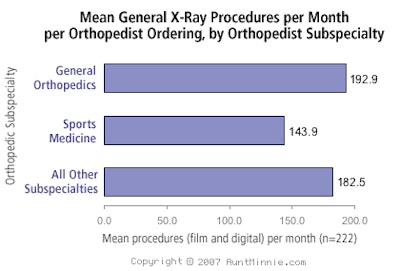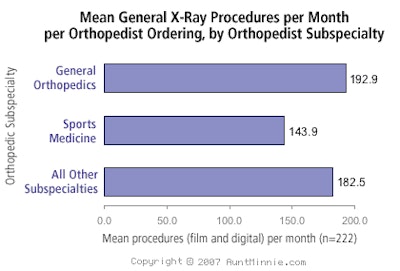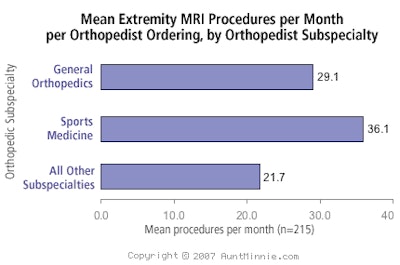
For more and more orthopedic practices, in-house MRI and digital x-ray imaging have become the first picks on the wish list. It makes sense: Rather than requiring patients to suffer long waits for diagnostic MRI or general x-ray exams at a hospital or outpatient radiology center, orthopedists with equipment in their offices can offer quicker results, even if the majority of in-office exams are still sent out for interpretation.
A report published this month by Des Plaines, IL-based IMV Medical Information Division, "Present Practices & Future Directions in Orthopedic Imaging: The Orthopedists' Perspective 2007," describes access to in-office MRI and digital x-ray as two of the greatest unmet needs for U.S. orthopedists. It includes data from 225 orthopedic practices across the U.S. (which represent 758 orthopedists working in both private and multispecialty environments), and investigates these clinicians' imaging modality preferences for musculoskeletal, trauma, and spinal applications, as well as preoperative planning, intraoperative imaging, and postoperative follow-up. The report also explores the mix of orthopedic procedures that are referred versus those that are performed within the practice for each modality.
Monthly volumes of diagnostic imaging procedures ordered by orthopedic specialists presently average 263 per physician across eight major imaging modalities, according to the survey. General x-ray orders, both film-based and digital, represent about 180 procedures per month, or about 68% of the total. MRI exams of extremities are the second most frequently ordered procedure, followed by whole-body MRI exams.
 |
 |
Seventeen percent of the report's respondents said they refer all their general x-ray procedures, while 51% said they perform all of their own. The remaining 32% refer out a quarter or less of their x-ray exams. Forty-three percent of those surveyed said the x-ray procedures they order are interpreted by other orthopedists. More than a third of the study participants said that these procedures are performed in a hospital radiology department.
Study respondents said they almost always use general x-ray to evaluate osteoarthritis and upper-extremity trauma; 90% use it to image rheumatoid arthritis, lower-extremity trauma, and overuse injuries, and for presurgical planning.
Although the majority of those surveyed reported that their general x-ray procedures are performed using film, interest in bringing digital radiography into orthopedic practice is high, with many of the orthopedists surveyed saying they plan to purchase or lease DR units within the next three years.
After general x-ray, MRI is the second most frequently used imaging modality in orthopedic practices, according to the report, whether an MRI exam is done on a whole-body device or on one dedicated to extremity imaging. Those who participated in the study order about twice as many MRI procedures of the extremities as compared to whole-body MRI exams. Many of those surveyed intend to acquire extremity MRI equipment in the next three years.
MRI exams are used by more than 70% of the study participants for bone cancer imaging; by more than 60% for presurgical planning; by 50% for evaluating trauma, including spinal and upper and lower extremities; and by 25% for diagnosing osteoarthritis. More than 95% of orthopedists who participated in the survey routinely order extremity MRI exams, most likely for evaluating bone tumors, overuse injuries of the extremities, presurgical planning, and upper-extremity trauma.
In the next three years, 37.1% of the survey respondents expect orders of whole-body MRI to increase, with those who specialize in sports medicine and spinal surgery leading the trend.
Arthrography exams image the interior of the joint under contrast media; the study found that 80% of the respondents order arthrography procedures using x-ray, fluoroscopy, or CT imaging (for an average of 12.2 arthrography procedures per month), and more than 70% order MR arthrography (for an average of about 7.5 procedures per month). Two-thirds of survey respondents refer all of their non-MR arthrography exams outside their practices; the remaining 28.8% perform the procedures in-house. Eighty-five percent said that their non-MR arthrography exams are interpreted by radiologists, while 95% said that their MR arthrography procedures are read by radiologists.
Almost half (49.1%) of study respondents cited routine x-ray procedures as the main diagnostic imaging referral for which they compete with radiologists. The report also found that sports medicine specialists are more likely to compete with radiologists for MRI procedures than general orthopedists, while general orthopedists are more likely to compete with radiologists for dual-energy x-ray absorptiometry (DEXA) exams.
As for prioritizing selection criteria for diagnostic equipment purchases, the study found that equipment price was the main factor, with quality of service coming in second, particularly for private practitioners.
By Mary Patton
AuntMinnie.com contributing writer
March 28, 2007
Mary Patton is director of market research at IMV Medical Information Division and the author of IMV's "Present Practices & Future Directions in Orthopedic Imaging: The Orthopedists' Perspective 2007." For further details and information, visit IMV's Web site at www.imvlimited.com or call 847-297-1404.
Related Reading
Orthopedic specialists eye MRI, DR, March 6, 2007
AuntMinnie.com MarketStat #47: MRI adult versus pediatric patient visit mix, February 16, 2007
Multiple industry trends increase demand for subspecialty radiology, October 5, 2006
In-office MRI spurs boom in MSK teleradiology, September 9, 2005
3-tesla MR enhances, and likely advances, orthopedic imaging, February 22, 2005
Copyright © 2007 AuntMinnie.com
Disclosure notice: AuntMinnie.com is owned by IMV, Ltd.



















